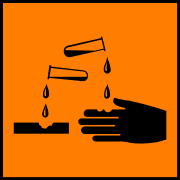|
Buffer solutions may be made directly by mixing weak acids/bases with their salts or by reaction between weak acids/bases and strong base/acid to produce the required mixture. |
|
Preparation of an acidic buffer
The simplest way of preparing a buffer solution is to dissolve a known quantity of the salt of the weak acid (or base) in a solution of weak acid (or base) of known concentration.
|
Example Sodium ethanoate is the salt of a weak acid - it has the formula CH3COONa (relative molecular mass = 82) If 8.2 g of sodium ethanoate are dissolved in 100 cm3 of ethanoic acid then: The concentration of the sodium ethanoate is equal to 0.1/0.1 = 1M The concentration of the ethanoic acid = 1M Therefore the buffer solution will have pKa = pH Therefore the buffer has a pH value of 4.78 |
Preparation of a basic buffer
A basic buffer is prepared using a weak base and its salt. The classic example is ammonia solution and ammonium chloride.
- Ammonia solution is the weak base - NH3(aq)
- Ammonium chloride is the salt of ammonia - NH4Cl(aq)
The pOH of the solution may be calculated using the pkb value of ammonia (4.75), or the Kb of ammonia (1.78 x 10-5). Once the pOH is found, the pH is calculated using the relationship pH + pOH = 14.
|
Example: Calculate the pH of a buffer solution consisting of a 0.2 mol dm-3 solution of ammonium chloride in 0.1 mol dm-3 ammonia solution (pKb = 4.75). The base equilibrium expression: Separate out the [OH-] Take logs throughout Now multiply through by minus (-1) (Notice that ammonia and ammonium ion have now changed places) The fraction [NH3]/[NH4+] = 1/2 = 0.5 Log 0.5 = -0.3 Therefore pKb = pOH - 0.3 pOH = 4.75 + 0.3 = 5.05 Therefore pH of the buffer solution = 14 - 5.05 = 8.95 |
Preparation of a buffer by neutralisation
Another way to prepare a buffer solution (much favoured by examiners) is to neutralise an excess of weak acid (or weak base) with some strong base (or strong acid). The neutralisation produces the salt of the weak acid (or base) 'in situ' and, as the weak acid was in excess, there will still be some weak acid in the mixture. The resultant mixture contains both the salt of the weak acid and the weak acid itself.
|
Example: Find the pH of the solution formed by adding 50cm3 sodium hydroxide (1M) solution to 100 cm3 (1M) ethanoic acid. Moles of sodium hydroxide added = 0.05 x 1 = 0.05 moles This neutralises an equal number of moles of the ethanoic acid = 0,05 moles and produce exactly 0,05 moles of sodium ethanoate
The concentration of the sodium ethanoate produced = 0.05 moles / 0.1 dm3 = 0.5M The total initial acid moles = 1 x 0.1 = 0.1 moles Moles of acid reacted with sodium hydroxide = 0.05 moles Therefore moles of acid remaining = 0.1 - 0.05 = 0.05 moles Therefore molarity of acid = 0.05 /0.1 = 0.5 M The buffer solution pH can then be obtained from the buffer law: pKa = pH + log[ethanoic acid]/[ethanoate ion] pH = pKa - log[ethanoic acid]/[ethanoate ion] pH = pKa - log 1 pH = pKa In this case the concentration of the acid and the salt are equal and pH = pKa. This represents a rapid shortcut in questions of this type. If it can be shown that the weak acid concentration (or the weak base concentration) equals the salt concentration then pH = pKa and NO calculation needs to be carried out! |


